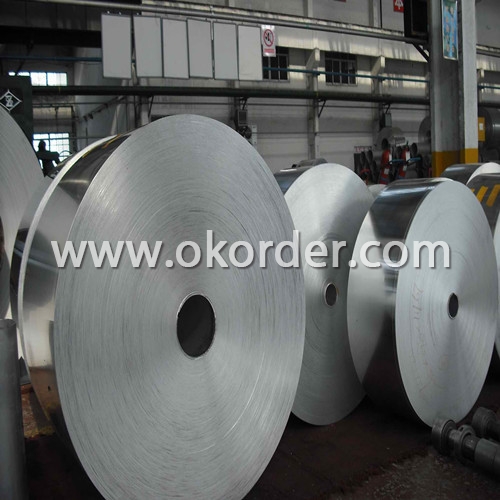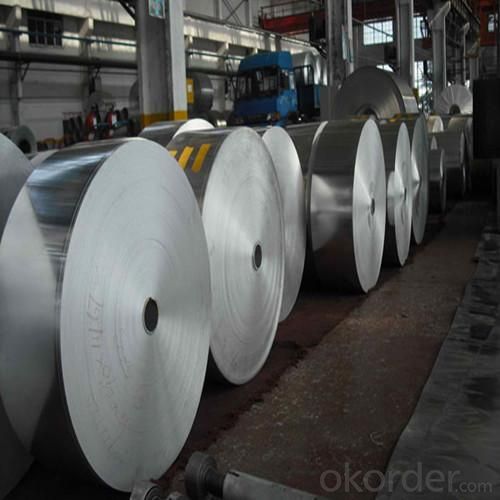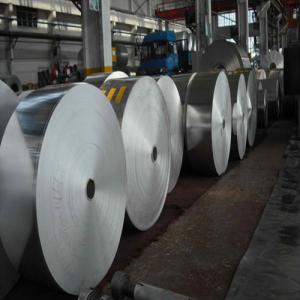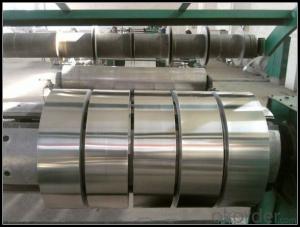Aluminum Strips Menards AA1050
- Loading Port:
- China Main Port
- Payment Terms:
- TT or LC
- Min Order Qty:
- 5 Tons m.t.
- Supply Capability:
- 1000 Tons Per Month m.t./month
OKorder Service Pledge
OKorder Financial Service
You Might Also Like
1. Specifications of Aluminum Strips AA1050
Alloy Number | AA1050 |
Temper | Temper H12, H14, H16, H18, H22, H24, H26, H32,HO, F |
Thickness | 0.10-500mm |
Diameter | 10mm- 2200mm |
Standard | GB/T3880-2006, ASTM, ISO, EU standard |
Special specification is available on customers' requirements.




2. Usage/Applications of Aluminum Strips AA1050
Aluminum strips are widely used for PS printed materials substrate, building decoration materials, stamping products, building mirror materials, nameplate, insulation materials, aluminum plastic composite material, capacitor strip, transformer strip, welding parts, heat exchanger, clock surface and disk, kitchen utensils, reflecting apparatus etc.
3. Packaging & Delivery of Aluminum Strips AA1050
Packaging: Seaworthy package, bubble plastic bag inside, anti-moisture paper wrapped outside, covered with cartons, on wooden pallets, in containers. Pallet weight: Max. 2.30 tons.
Shipment: the goods will be delivered in 30 days after getting the buyer's payment.



4. Production Flow of Aluminum Strips AA1050
Rolling--Annealing--Slitting—Sawing, Cut-To-Length, Shearing
- Q: What gas is best for welding aluminum strip?
- If you are using the gas, liquefied gas gun can be used separately burning liquefied petroleum gas welding, then burning gas is liquefied gas, but this time need to use low temperature welding wire, such as the WEWELDING M51 with WEWELDING M51-F solder welding wire.
- Q: This question asks for the cost involved in the production of aluminum strips.
- <p>The cost of aluminum strip production varies significantly and depends on several factors including the cost of raw materials, energy costs, labor, machinery, and market demand. Additionally, the cost can be influenced by the scale of production, efficiency of the production process, and the specific grade or alloy of aluminum used. As of 2023, the cost of aluminum on the London Metal Exchange (LME) is a key factor, as it represents the base price for aluminum. However, to get an accurate cost for aluminum strip production, one would need to consider all these variables and possibly consult with industry-specific cost analysis or directly with aluminum producers for the most current and detailed figures.</p>
- Q: Is it possible to construct an energy-efficient wall using aluminum strips compared to other materials?
- <p>Aluminum strips alone may not be the best choice for constructing an energy-efficient wall. Aluminum is a good conductor of heat, which means it can transfer heat quickly and isn't ideal for insulation. However, aluminum can be used in combination with insulating materials to enhance energy efficiency. For instance, aluminum composite panels with a core of insulation material can provide both structural strength and thermal insulation. The key to energy-efficient walls is to use materials with high R-values (thermal resistance), such as fiberglass, cellulose, or polyurethane foam. These materials, when combined with aluminum in a composite panel, can create a wall system that is both durable and energy-efficient.</p>
- Q: This question asks about the uses of aluminum strips within the construction industry.
- <p>Aluminum strips are widely used in construction due to their strength, durability, and resistance to corrosion. They are commonly used in the manufacturing of window and door frames, as they are lightweight and provide excellent thermal insulation. Aluminum strips are also used in the construction of scaffolding, roofing, and cladding systems due to their high strength-to-weight ratio and ease of installation. Additionally, they are employed in electrical wiring as conduits and in the framing of structural components due to their non-magnetic and non-sparking properties, making them safe for use around electrical equipment.</p>
- Q: What are the environmental regulations that impact the production and usage of aluminum strips?
- <p>Yes, there are several environmental regulations that affect the production and use of aluminum strips. These include regulations on emissions, waste disposal, and energy consumption. For instance, the European Union's Industrial Emissions Directive sets standards for emissions from aluminum production facilities. In the United States, the Environmental Protection Agency (EPA) enforces regulations such as the Clean Air Act and Resource Conservation and Recovery Act (RCRA), which impact how aluminum is produced and used. These regulations aim to minimize pollution, conserve resources, and promote recycling, thereby influencing the aluminum industry's practices globally.</p>
- Q: This question asks for the distinctions between a roof made from an aluminum strip and a general metal roof. It seeks to understand the specific characteristics that differentiate these two types of roofing materials.
- <p>An aluminum strip roof is a specific type of metal roof, characterized by its lightweight and flexibility. Aluminum strips are often used for their corrosion resistance and durability. They are typically interlocking and can be easily bent to fit various roof shapes. In contrast, a metal roof is a broader category that includes various types of metal materials, such as steel, zinc, or copper, used for roofing. Metal roofs can be made from solid sheets, tiles, or strips, and they offer different levels of weight, durability, and maintenance requirements. While both are long-lasting and resistant to weather, the choice between an aluminum strip roof and other metal roofs often comes down to specific project needs, cost, and aesthetic preferences.</p>
- Q: This question asks about the differences between aluminum and stainless steel in terms of their ability to resist corrosion.
- <p>Yes, there are differences between aluminum and stainless steel in terms of corrosion resistance. Aluminum is highly resistant to corrosion due to the formation of a protective oxide layer on its surface, which prevents further oxidation. This makes it suitable for environments with high moisture or exposure to corrosive substances. Stainless steel, on the other hand, also has good corrosion resistance, especially when it contains higher amounts of chromium, which forms a passive film that protects the metal from corrosion. However, stainless steel can be more susceptible to corrosion in certain environments, such as those with chlorides, compared to aluminum.</p>
- Q: What are the distinctions between pure aluminum and its alloys?
- <p>Aluminum and aluminum alloys have distinct properties. Pure aluminum is a soft, lightweight metal with good thermal and electrical conductivity. It is highly reflective and resistant to corrosion. Aluminum alloys, on the other hand, are made by combining aluminum with other elements such as copper, magnesium, or silicon to enhance its strength, durability, and resistance to heat and wear. These alloys are stronger and more versatile than pure aluminum, making them suitable for a wide range of applications, from aerospace to construction.</p>
- Q: What are the elements or materials that make up aluminum strips?
- <p>Aluminum strips are primarily composed of aluminum, which is a lightweight and malleable metal with the chemical symbol Al and atomic number 13. They may also contain trace amounts of other elements such as copper, magnesium, manganese, silicon, and zinc, depending on the specific alloy. These additional elements are often added to enhance properties such as strength, corrosion resistance, or workability. Pure aluminum is soft and not commonly used for strips; instead, aluminum alloys are preferred for their improved characteristics.</p>
- Q: Can the 6 square aluminum wires carry 3 pieces of air?
- Sure, the 3 air conditioners are less than 3 kilowatts. That's perfectly all right.
1. Manufacturer Overview
| Location | Henan,China |
| Year Established | 2002 |
| Annual Output Value | Above US$200 Million |
| Main Markets | Mid East;Eastern Europe;North America |
| Company Certifications | ISO 9001:2000;ISO 14001:2004;OHSAS 18001 |
2. Manufacturer Certificates
| a) Certification Name | |
| Range | |
| Reference | |
| Validity Period |
3. Manufacturer Capability
| a) Trade Capacity | |
| Nearest Port | Shanghai |
| Export Percentage | 30%-50% |
| No.of Employees in Trade Department | 21-50 People |
| Language Spoken: | English;Chinese |
| b) Factory Information | |
| Factory Size: | Above 100,000 square meters |
| No. of Production Lines | Above 10 |
| Contract Manufacturing | OEM Service Offered;Design Service Offered |
| Product Price Range | Average |
Send your message to us
Aluminum Strips Menards AA1050
- Loading Port:
- China Main Port
- Payment Terms:
- TT or LC
- Min Order Qty:
- 5 Tons m.t.
- Supply Capability:
- 1000 Tons Per Month m.t./month
OKorder Service Pledge
OKorder Financial Service
Similar products
Hot products
Hot Searches
Related keywords





























